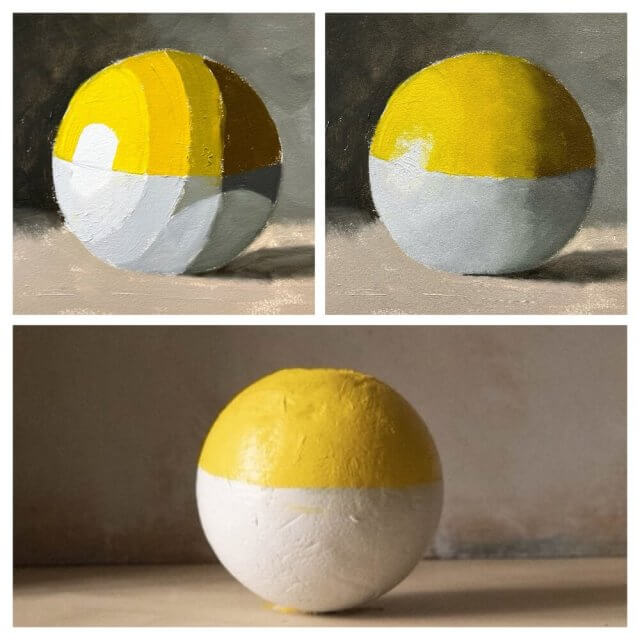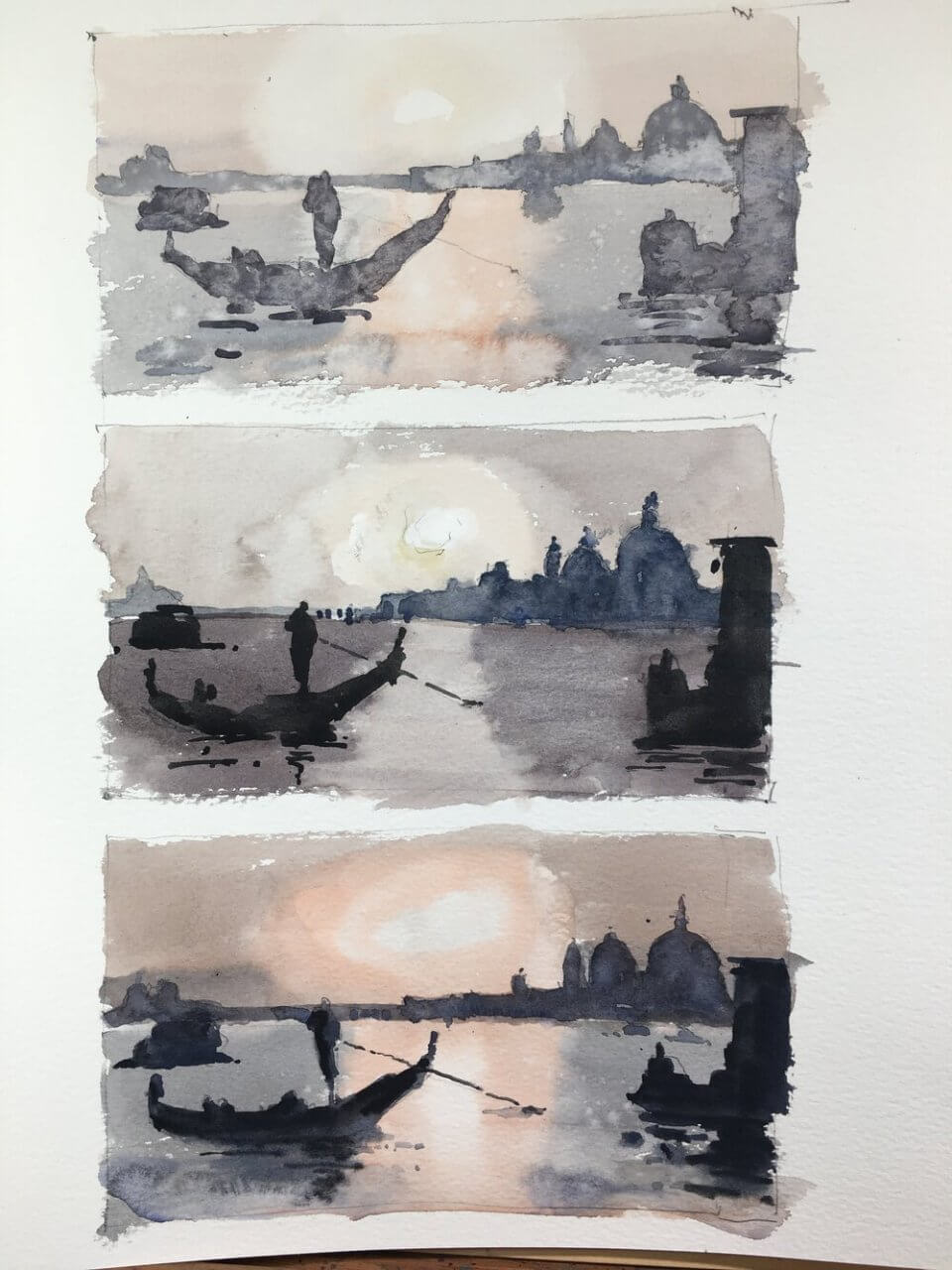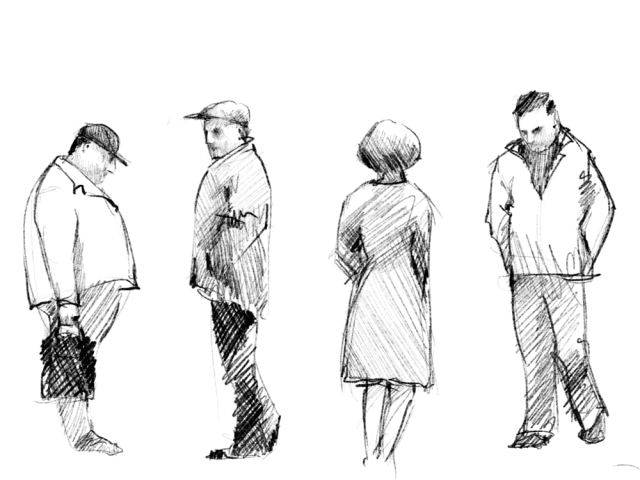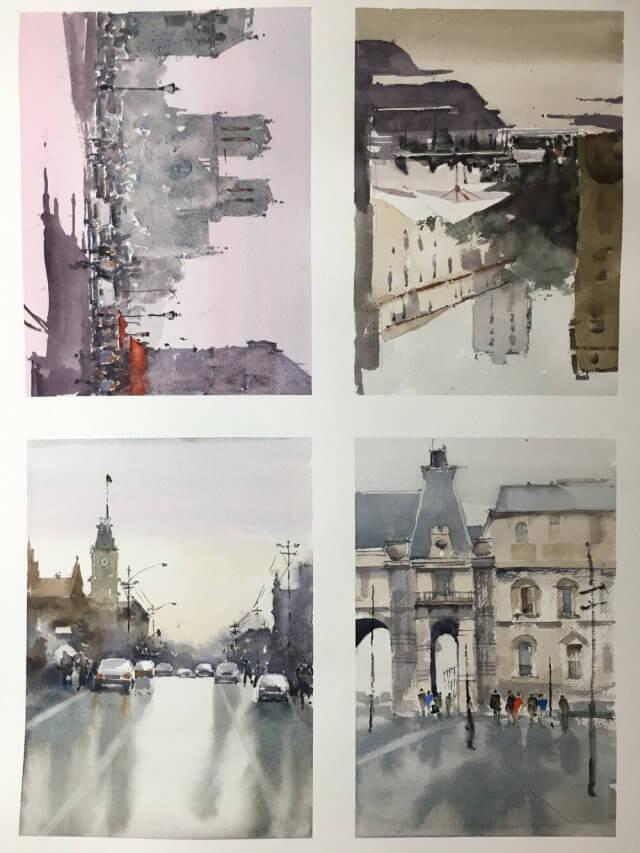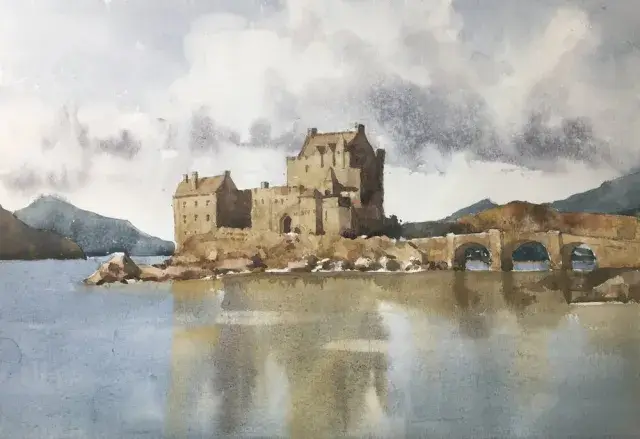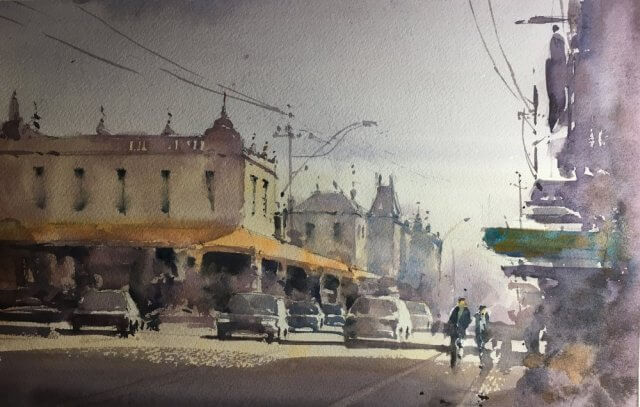Category: Tutorials
Venice and Watercolor Value Studies
Varying the value range alters a painting’s feel
The plan behind venice and watercolor value studies is the following. Take a reference and paint it three times. The middle one is painted as closely to the actual value range in the reference as possible. The top one is shifting and compressing the value range to the top i.e. lighter than the reference. And similarly the bottom one is shifting and compressing the value range to the bottom i.e. darker.
Change the values but keep the value relationships
The first goal with these studies was to see whether we could shift the values but still keep the value relationships. If the relationships are good then the scene will read correctly. And I think they all do. None of them are great paintings but you can see they all represent the same thing.
Shift the values to change the atmosphere
The second goal was to change the feel of a painting by shifting the values. I thought the lighter one might have a more misty, ethereal feel. And the darker one would be more moody. Well I don’t think I succeeded here. Maybe I’m over simplifying the process. But it definitely an exercise worth doing.
Some days nothing really works
Wasn’t really feeling it for this one. Let’s hope I can pull something out of the bag for tomorrow’s class. In any case it was good practice for value studies. I’ve also included a larger version below. Again I’m not really happy with it – just one of those days I suppose.
And a link to someone who can really nail this – Joseph Zbukvic
A lot of you will know of Joseph Zbukvic. His value handling (amongst many other things) is spectacular.

Yes well we’re all depressed now aren’t we? He actually uses quite a narrow range of values here but expertly implemented.
Nighttime People Doodling
Learning from Zbukvic and Chien Chung Wei
Eilean Donan Castle Watercolor Painting
This step by step Eilean Donan Castle watercolor painting is in muted tones. It’s always a favorite and there isn’t a view of this that isn’t worth painting. I especially loved the warm ochres of the castle contrasting with the blues of the sky and water. This watercolor castle tutorial was great fun to do. If you try it I’d love to see what you do!
The Castle Drawing is Simple and in Outline
We only want an indication of the castle and its surroundings on the paper. So no detail in the walls and very few windows or twiddly bits. There are also no pencil marks in the sky or the water. We’ll put the clouds and the reflections in as we paint.
Work out your color mixes ahead of time
Before even starting to paint the castle watercolor I did some color swatches on a piece of scrap paper. This allows me to do some planning and thinking ahead of time. When you’re in the middle of a watercolor painting there’s very little time to waste. The paint is drying and you have to get those marks right before they dry. So anything we can work out before we get the brushes wet the better.
I’ve also included Munsell notation for the colors. This isn’t really necessary (although I find it very useful) as long as you try and match that color as close as you can from the reference.
My process is I match the important areas to the Munsell system and practice hitting the right hue, value, and chroma. I can always tell if the color palette will result in a harmonious picture from the result. Definitely looked good for this one.
I you want to know more about how the Munsell color system can help click through to this post. It also includes information about the online ChromaMagic tool which helps you see color more accurately.
Start your Castle Watercolor Painting with the Sky
I started with the sky and worked it wet in wet. This keeps the edges of the clouds soft. While the paper is still wet you can drop in slightly darker color to indicate the shadows on the undersides of the clouds.
The background mountains went in next. These are suprisingly dark but I kept the colors muted towards grey. They form a good backdrop to the castle itself and the dark color provides a nice contrast.
Castle Watercolor Painting – First Layer for the Walls
We’re going to paint the castle itself in layers. I’ve painted a few watercolor castles and I find this gives a great effect. So we don’t want any detail in this first layer. This will be the base layer of the walls. You can add some texture into this by using a water spray bottle or splattering some water with your brush.
Painting the Water and Reflections
The water and reflections needs to be soft so I made the paper wet with a clean brush full of water. I then brushed in the reflections of the sky and the castle walls and dragged them down slightly to get the reflection effect. As the paper is wet when we do this the colors meld together. This isn’t the final step in the reflections yet but I wanted to get something on the paper to be able to judge the rest of it more easily.
Now the Magic Happens! The Shadows
This is where the magic happens! It’s the best bit! The painting has been looking a little flat up to this point. We’ve put all the first layers in but we have no darks in there! These are what will give a sense of three dimensions to the castle and add some interest to the painting.
The shadows are put in simply with a darker wash of ultramarine and burnt sienna. The darks go in on the side of the castle away from the light (the right) and also under the arches of the bridge. I also start to put in some shadows for the rocks at the base of the building.

Online Zoom Classes
I run online zoom courses regularly for both beginners and more advanced students. Please check out my workshop page.
Finishing the Castle – Windows and Doors
Things are looking a lot better now. Phew! Now the main shadows are in and working I can put in the details for the windows, chimneys and doors. Note that if the previous step hasn’t worked and you don’t have something that’s reading as three-dimensional no amount of detail will fix it. I know – I’ve been there many times.
And go careful with the details. The windows may look dark but they only need to be a shade or two darker than the walls. They’ll really stand out and catch the eye if you put them in close to black.
Final Steps in your Castle Watercolor Painting

I was fairly happy at this point but I knew that the water and reflections were too light. I washed over the water again with a glaze of blue, light and dark brown. This gives the water a definite value change compared to the sky and makes the painting’s composition more harmonious. As a final touch I took a very dry synthetic brush and dragged horizontally through the reflection area. This has to be done while the paint is still wet and gives an effect of ripples on the water.
Final Thoughts….
This was a really enjoyable watercolor painting to paint. There were a few hairy moments along the way (aren’t there always) but it all came together in the end. I still really like the color scheme. Only a few colors used but they work together well.
And Before You Go – Another Castle Watercolor Painting!
I didn’t video this painting but I have another version that can be viewed below, on my video page or on my youtube channel.

Learning Time – Zbukvic Day 3
Stepping it up a bit today and completed 4 paintings. All are from Zbukvic originals. I was hoping that a fast turnaround would speed up the learning process and consolidate some things into muscle memory.
Before the pictures a summary. None of these came out as paintings. They’re obviously sketches or studies but I started to soak in a few things.
Shapes. A few big shapes, more smaller shapes. Make sure the negative space is also an interesting shape.
- Values. Keep the values even in the big shapes (with a little variation for interest) and you only really need 4 or 5 to make the picture work.
- Color – ugh. Still need to work on this.
- Texture. This was hard. Mr Zbukvic has lots of lovely slight variation in his washes which I really struggle to get.
- Drawing – Surprisingly simple to draw out these paintings. Lots of simplification has already been done by Mr Z.
Anything else? I think I improved as the day went on and was making the paintings more mine than copying the original. No great breakthroughs but definitely worthwhile.
So to the paintings – in reverse order :
This was the last and I think the most successful. I’d got used to the sequence of washes – lightest in sky and the sunlit parts of the buildings. Second the background and shadows on the buildings. 3rd – cars and dark recesses. 4th and final – people and the foreground and other bits and pieces.
I’d also started to get used to some of the wet in wet for windows and background mistiness.
Next one – number 3 :
Struggled with this one. The original has lots of variation in the darks which I just wasn’t getting. The strong composition makes this one – especially the foreground shadow – which is of course all Mr Z’s doing.
Next one – number 2
This had quite a lot I liked. The color came out well. The combination of dull orange and the purple shadows worked without being too in your face. The center of interest has nice lots of choppy darks and lights which read well without specifically being anything. So not great but not too bad.
Finally – number 1
Again this didn’t come out too badly. I was feeling my way at this point and you can see the background washes are a bit muddy. Nice choppiness in the center of interest and the combination of darks and lights worked well.
So it was a busy day. As usual I’m too close to things to really assess whether it was worthwhile. It’s certainly a different beast copying paintings rather than scenes. The simplification and composition has already been done for you which are two things you don’t have to worry about. Once the drawing is done it’s a case of identifying which value wash goes where and trying not to get too fiddly. I think after another day of these (I have nine in total to have a go at) I’ll concentrate on extreme simplification of some of my own scenes.
